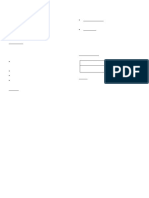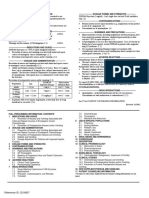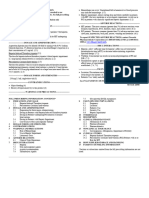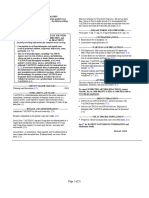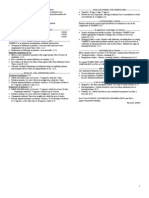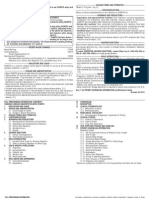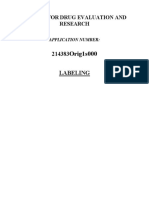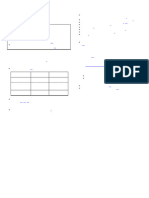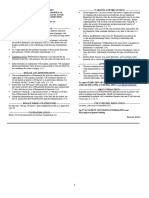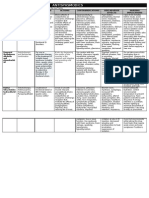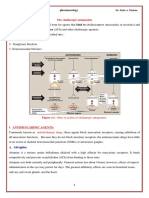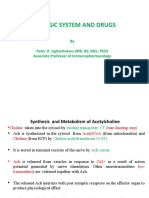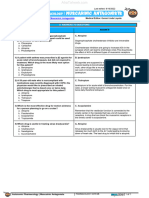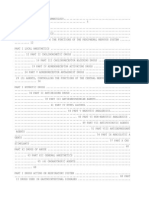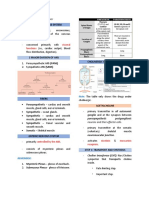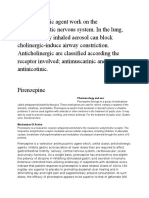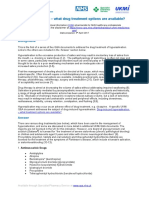S 015 LBL
S 015 LBL
Uploaded by
Дѵдԁнєѕн ҮдԁдѵCopyright:
Available Formats
S 015 LBL
S 015 LBL
Uploaded by
Дѵдԁнєѕн ҮдԁдѵOriginal Title
Copyright
Available Formats
Share this document
Did you find this document useful?
Is this content inappropriate?
Copyright:
Available Formats
S 015 LBL
S 015 LBL
Uploaded by
Дѵдԁнєѕн ҮдԁдѵCopyright:
Available Formats
HIGHLIGHTS OF PRESCRIBING INFORMATION --------------------- DOSAGE FORMS AND STRENGTHS---------------------
These highlights do not include all the information needed to use • 0.05 mg/mL injection in Ansyr™ Plastic Syringe (3)
ATROPINE SULFATE INJECTION safely and effectively. See full • 0.1 mg/mL injection in Ansyr™ Plastic Syringe (3)
prescribing information for ATROPINE SULFATE INJECTION.
------------------------------ CONTRAINDICATIONS -----------------------------
ATROPINE SULFATE injection, for intravenous, intramuscular, None. (4)
subcuatenous or endotracheal use. ----------------------- WARNINGS AND PRECAUTIONS ----------------------
Initial U.S. Approval: 1960
Tachycardia (5.1)
--------------------------- INDICATIONS AND USAGE--------------------------- Glaucoma (5.2)
Atropine is a muscarinic antagonist indicated for temporary blockade of Pyloric obstruction (5.3)
severe or life threatening muscarinic effects. (1) Worsening urinary retention (5.4)
Viscid bronchial plugs (5.5)
-----------------------DOSAGE AND ADMINISTRATION ----------------------
------------------------------ ADVERSE REACTIONS -----------------------------
• For intravenous administration, but may also be administered via
subcutaneous, intramuscular or via an endotracheal tube (2.1, 2.3). Most adverse reactions are directly related atropine’s antimuscarinic action.
Dryness of the mouth, blurred vision, photophobia and tachycardia commonly
• Titrate according to heart rate, PR interval, blood pressure and
occur with chronic administration of therapeutic doses. (6)
symptoms. (2.1)
• Adult dosage
To report SUSPECTED ADVERSE REACTIONS, contact Hospira, Inc.
- Antisialagogue or for antivagal effects: Initial single dose of
at 1-800-441-4100 or FDA at 1-800-FDA-1088 or www.fda.gov/medwatch.
0.5 mg to 1 mg. (2.2)
- Antidote for organophosporous or muscarinic mushroom ------------------------------ DRUG INTERACTIONS-------------------------------
poisoning: Initial single dose of 2 mg to 3 mg, repeated every 20 Mexiletine: Decreases rate of mexiletine absorption. (7.1)
30 minutes. (2.2)
- Bradyasystolic cardiac arrest: 1 mg dose, repeated every 3-5 Revised: 10/2015
minutes if asystole persists. (2.2)
• Patients with Coronary Artery Disease: Total dose should not exceed
0.03 mg/kg to 0.04 mg/kg. (5.1)
_______________________________________________________________________________________________________________________________
FULL PRESCRIBING INFORMATION: CONTENTS*
1 INDICATIONS AND USAGE 8 USE IN SPECIFIC POPULATIONS
2 DOSAGE AND ADMINISTRATION 8.1 Pregnancy
2.1 General Administration 8.3 Pediatric Use
2.2 Adult Dosage 8.5 Geriatric Use
2.3 Pediatric Dosage 10 OVERDOSAGE
3 DOSAGE FORMS AND STRENGTHS 11 DESCRIPTION
4 CONTRAINDICATIONS 12 CLINICAL PHARMACOLOGY
5 WARNINGS AND PRECAUTIONS 12.1 Mechanism of Action
5.1 Tachycardia 12.2 Pharmacodynamics
5.2 Acute Glaucoma 12.3 Pharmacokinetics
5.3 Pyloric Obstruction 13 NONCLINICAL TOXICOLOGY
5.4 Complete Urinary Retintion 13.1 Carcinogenesis, Mutagenesis, Impairment of Fertility
5.5 Viscid Plugs 16 HOW SUPPLIED/STORAGE AND HANDLING
6 ADVERSE REACTIONS *Sections or subsections omitted from the full prescribing information are not
7 DRUG INTERACTIONS listed.
7.1 Mexiletine
__________________________________________________________________________________________
Reference ID: 3840480
FULL PRESCRIBING INFORMATION
1 INDICATIONS AND USAGE
Atropine Sulfate Injection, USP, is indicated for temporary blockade of severe or life threatening
muscarinic effects, e.g., as an antisialagogue, an antivagal agent, an antidote for
organophosphorus or muscarinic mushroom poisoning, and to treat bradyasystolic cardiac arrest.
2 DOSAGE AND ADMINISTRATION
2.1 General Administration
Parenteral drug products should be inspected visually for particulate matter and discoloration
prior to administration, whenever solution and container permit. Do not administer unless
solution is clear and seal is intact. Discard unused portion.
Intravenous administration is usually preferred, but subcutaneous, intramuscular, and
endotracheal administration are possible. For administration via an endotracheal tube, dilute 1-2
mg in no more than 10 mL of sterile water or normal saline.
Titrate based on heart rate, PR interval, blood pressure and symptoms.
2.2 Adult Dosage
Table 1: Recommended Dosage
Use Dose (adults) Repeat
Antisialagogue or 0.5 to 1 mg 1-2 hours
other antivagal
Organophosphorus or 2 to 3 mg 20-30 minutes
muscarinic mushroom
poisoning
Bradyasystolic 1 mg 3-5 minutes; 3 mg
cardiac arrest maximum total dose
2.3 Pediatric Dosage
Dosing in pediatric populations has not been well studied. Usual initial dose is 0.01 to 0.03
mg/kg.
3 DOSAGE FORMS AND STRENGTHS
Injection: 0.05 mg/mL and 0.1 mg/mL in Ansyr™ Plastic Syringes
4 CONTRAINDICATIONS
None.
5 WARNINGS AND PRECAUTIONS
5.1 Tachycardia
Reference ID: 3840480
When the recurrent use of atropine is essential in patients with coronary artery disease, the total
dose should be restricted to 2 to 3 mg (maximum 0.03 to 0.04 mg/kg) to avoid the detrimental
effects of atropine-induced tachycardia on myocardial oxygen demand.
5.2 Acute Glaucoma
Atropine may precipitate acute glaucoma.
5.3 Pyloric Obstruction
Atropine may convert partial organic pyloric stenosis into complete obstruction.
5.4 Complete Urinary Retention
Atropine may lead to complete urinary retention in patients with prostatic hypertrophy.
5.5 Viscid Plugs
Atropine may cause inspissation of bronchial secretions and formation of viscid plugs in patients
with chronic lung disease.
6 ADVERSE REACTIONS
The following adverse reactions have been identified during post-approval use of atropine
sulfate. Because these reactions are reported voluntarily from a population of uncertain size, it is
not always possible to reliably estimate their frequency or establish a causal relationship to drug
exposure.
Most of the side effects of atropine are directly related to its antimuscarinic action. Dryness of
the mouth, blurred vision, photophobia and tachycardia commonly occur. Anhidrosis can
produce heat intolerance. Constipation and difficulty in micturition may occur in elderly patients.
Occasional hypersensitivity reactions have been observed, especially skin rashes which in some
instances progressed to exfoliation.
7 DRUG INTERACTIONS
7.1 Mexiletine
Atropine Sulfate Injection decreased the rate of mexiletine absorption without altering the
relative oral bioavailability; this delay in mexiletine absorption was reversed by the combination
of atropine and intravenous metoclopramide during pretreatment for anesthesia.
8 USE IN SPECIFIC POPULATIONS
8.1 Pregnancy
Pregnancy Category C
Animal reproduction studies have not been conducted with atropine. It also is not known whether
atropine can cause fetal harm when given to a pregnant woman or can affect reproduction
capacity.
8.3 Nursing Mothers
Trace amounts of atropine was found in breast milk. The clinical impact of this is not known.
8.5 Geriatric Use
Reference ID: 3840480
An evaluation of current literature revealed no clinical experience identifying differences in
response between elderly and younger patients. In general, dose selection for an elderly patient
should be cautious, usually starting at the low end of the dosing range, reflecting the greater
frequency of decreased hepatic, renal, or cardiac function, and of concomitant disease or other
drug therapy.
10 OVERDOSAGE
Excessive dosing may cause palpitation, dilated pupils, difficulty in swallowing, hot dry skin,
thirst, dizziness, restlessness, tremor, fatigue and ataxia. Toxic doses lead to restlessness and
excitement, hallucinations, delirium and coma. Depression and circulatory collapse occur only
with severe intoxication. In such cases, blood pressure declines and death due to respiratory
failure may ensue following paralysis and coma.
The fatal adult dose of atropine is not known. In pediatric populations, 10 mg or less may be
fatal.
In the event of toxic overdosage, a short acting barbiturate or diazepam may be given as needed
to control marked excitement and convulsions. Large doses for sedation should be avoided
because central depressant action may coincide with the depression occurring late in atropine
poisoning. Central stimulants are not recommended.
Physostigmine, given as an atropine antidote by slow intravenous injection of 1 to 4 mg (0.5 to 1
mg in pediatric populations), rapidly abolishes delirium and coma caused by large doses of
atropine. Since physostigmine is rapidly destroyed, the patient may again lapse into coma after
one to two hours, and repeated doses may be required.
Artificial respiration with oxygen may be necessary. Ice bags and alcohol sponges help to reduce
fever, especially in pediatric populations.
Atropine is not removed by dialysis.
11 DESCRIPTION
Atropine Sulfate Injection, USP is a sterile, nonpyrogenic isotonic solution of atropine sulfate
monohydrate in water for injection with sodium chloride sufficient to render the solution
isotonic. It is administered parenterally by subcutaneous, intramuscular or intravenous injection.
Each milliliter (mL) contains 0.1 mg (adult strength) or 0.05 mg (pediatric strength) of atropine
sulfate monohydrate equivalent to 0.083 mg (adult strength) or 0.042 mg (pediatric strength) of
atropine, and sodium chloride, 9 mg. May contain sodium hydroxide and/or sulfuric acid for pH
adjustment 0.308 mOsmol/mL (calc.). pH 4.2 (3.0 to 6.5).
Sodium chloride added to render the solution isotonic for injection of the active ingredient is
present in amounts insufficient to affect serum electrolyte balance of sodium (Na+) and chloride
(Cl-) ions.
Reference ID: 3840480
The solution contains no bacteriostat, antimicrobial agent or added buffer (except for pH
adjustment) and is intended for use only as a single-dose injection. When smaller doses are
required the unused portion should be discarded.
Atropine Sulfate, USP is chemically designated 1α H, 5α H-Tropan-3-α-ol (±)-tropate (ester),
sulfate (2:1) (salt) monohydrate, (C17H23NO3)2 · H2SO4 · H2O, colorless crystals or white
crystalline powder very soluble in water. It has the following structural formula:
Atropine, a naturally occurring belladonna alkaloid, is a racemic mixture of equal parts of d- and
1-hyocyamine, whose activity is due almost entirely to the levo isomer of the drug.
Sodium Chloride, USP is chemically designated NaCl, a white crystalline powder freely soluble
in water.
The syringe is molded from a specially formulated polypropylene. Water permeates from inside
the container at an extremely slow rate which will have an insignificant effect on solution
concentration over the expected shelf life. Solutions in contact with the plastic container may
leach out certain chemical components from the plastic in very small amounts; however,
biological testing was supportive of the safety of the syringe material.
12 CLINICAL PHARMACOLOGY
12.1 Mechanism of Action
Atropine is an antimuscarinic agent since it antagonizes the muscarine-like actions of
acetylcholine and other choline esters.
Atropine inhibits the muscarinic actions of acetylcholine on structures innervated by
postganglionic cholinergic nerves, and on smooth muscles which respond to endogenous
acetylcholine but are not so innervated. As with other antimuscarinic agents, the major action of
atropine is a competitive or surmountable antagonism which can be overcome by increasing the
concentration of acetylcholine at receptor sites of the effector organ (e.g., by using
anticholinesterase agents which inhibit the enzymatic destruction of acetylcholine). The
receptors antagonized by atropine are the peripheral structures that are stimulated or inhibited by
muscarine (i.e., exocrine glands and smooth and cardiac muscle). Responses to postganglionic
cholinergic nerve stimulation also may be inhibited by atropine but this occurs less readily than
with responses to injected (exogenous) choline esters.
Reference ID: 3840480
12.2 Pharmacodynamics
Atropine-induced parasympathetic inhibition may be preceded by a transient phase of
stimulation, especially on the heart where small doses first slow the rate before characteristic
tachycardia develops due to paralysis of vagal control. Atropine exerts a more potent and
prolonged effect on heart, intestine and bronchial muscle than scopolamine, but its action on the
iris, ciliary body and certain secretory glands is weaker than that of scopolamine. Unlike the
latter, atropine in clinical doses does not depress the central nervous system but may stimulate
the medulla and higher cerebral centers. Although mild vagal excitation occurs, the increased
respiratory rate and (sometimes) increased depth of respiration produced by atropine are more
probably the result of bronchiolar dilatation. Accordingly, atropine is an unreliable respiratory
stimulant and large or repeated doses may depress respiration.
Adequate doses of atropine abolish various types of reflex vagal cardiac slowing or asystole. The
drug also prevents or abolishes bradycardia or asystole produced by injection of choline esters,
anticholinesterase agents or other parasympathomimetic drugs, and cardiac arrest produced by
stimulation of the vagus. Atropine also may lessen the degree of partial heart block when vagal
activity is an etiologic factor. In some patients with complete heart block, the idioventricular rate
may be accelerated by atropine; in others, the rate is stabilized. Occasionally a large dose may
cause atrioventricular (A-V) block and nodal rhythm.
Atropine Sulfate Injection, USP in clinical doses counteracts the peripheral dilatation and abrupt
decrease in blood pressure produced by choline esters. However, when given by itself, atropine
does not exert a striking or uniform effect on blood vessels or blood pressure. Systemic doses
slightly raise systolic and lower diastolic pressures and can produce significant postural
hypotension. Such doses also slightly increase cardiac output and decrease central venous
pressure. Occasionally, therapeutic doses dilate cutaneous blood vessels, particularly in the
“blush” area (atropine flush), and may cause atropine “fever” due to suppression of sweat gland
activity in infants and small children.
The effects of intravenous atropine on heart rate (maximum heart rate) and saliva flow
(minimum flow) after I.V. administration (rapid, constant infusion over 3 min.) are delayed by 7
to 8 minutes after drug administration and both effects are non-linearly related to the amount of
drug in the peripheral compartment. Changes in plasma atropine levels following intramuscular
administration (0.5 to 4 mg doses) and heart rate are closely overlapped but the time course of
the changes in atropine levels and behavioral impairment indicates that pharmacokinetics is not
the primary rate-limiting mechanism for the central nervous system effect of atropine
12.3 Pharmacokinetics
Atropine disappears rapidly from the blood following injection and is distributed throughout the
body. Exercise, both prior to and immediately following intramuscular administration of
atropine, significantly increases the absorption of atropine due to increased perfusion in the
muscle and significantly decreases the clearance of atropine. The pharmacokinetics of atropine is
nonlinear after intravenous administration of 0.5 to 4 mg. Atropine’s plasma protein binding is
about 44% and saturable in the 2-20 μg/mL concentration range. Atropine readily crosses the
placental barrier and enters the fetal circulation, but is not found in amniotic fluid. Much of the
drug is destroyed by enzymatic hydrolysis, particularly in the liver; from 13 to 50% is excreted
Reference ID: 3840480
unchanged in the urine. Traces are found in various secretions, including milk. The major
metabolites of atropine are noratropine, atropin-n-oxide, tropine, and tropic acid. The
metabolism of atropine is inhibited by organophosphate pesticides.
Specific Populations
The elimination half-life of atropine is more than doubled in children under two years and the
elderly (>65 years old) compared to other age groups. There is no gender effect on the
pharmacokinetics and pharmacodynamics (heart rate changes) of atropine.
13 NONCLINICAL TOXICOLOGY
13.1 Carcinogenesis, Mutagenesis, Impairment of Fertility
Studies have not been performed to evaluate the carcinogenic or mutagenic potential of atropine
or its potential to affect fertility adversely.
16 HOW SUPPLIED/STORAGE AND HANDLING
Atropine Sulfate Injection, USP is supplied in single-dose containers as follows:
Container Concentration Fill Total NDC#
(mg/ml) Volume Atropine
Content
Ansyr™ Plastic Syringe 0.1 mg/mL (Adult) 5 mL 0.5 mg 0409-9629-05
Ansyr™ Plastic Syringe 0.1 mg/mL (Adult) 10 mL 1 mg 0409-1630-10
Ansyr™ Plastic Syringe 0.05 mg/mL (Pediatric) 5 mL 0.25 mg 0409-9630-05
Store at 20°C to 25°C (68°F to 77°F); excursions permitted between 15°C and 30°C (59°F and
86°F). [See USP Controlled Room Temperature.]
Printed in USA
Hospira, Inc., Lake Forest, IL 60045 USA
Reference ID: 3840480
You might also like
- RCP OnpatroDocument14 pagesRCP OnpatroMihaela BerindeieNo ratings yet
- Tropin Sulfat 1% FDADocument5 pagesTropin Sulfat 1% FDAUpik MoritaNo ratings yet
- WWW - Fda.gov/medwatch: Reference ID: 4419268Document8 pagesWWW - Fda.gov/medwatch: Reference ID: 4419268TNo ratings yet
- Prak8 - Brosur Obat Ventolin PDFDocument25 pagesPrak8 - Brosur Obat Ventolin PDFWAODE YUMNA ULTAMIL KARNONo ratings yet
- 213036s000lblDocument14 pages213036s000lblDivyansh ShuklaNo ratings yet
- MontelukastDocument25 pagesMontelukastMohammed shamiul ShahidNo ratings yet
- See Full Prescribing Information For Complete Boxed WarningDocument12 pagesSee Full Prescribing Information For Complete Boxed WarningEko YuliantoNo ratings yet
- S 032 LBLDocument13 pagesS 032 LBLBobeico TatianaNo ratings yet
- 020007s043lbl PDFDocument23 pages020007s043lbl PDFcenturionyegrosNo ratings yet
- ArgatrobanDocument18 pagesArgatrobanSuh TeixeiraNo ratings yet
- VALTOCO Prescribing InformationDocument26 pagesVALTOCO Prescribing Informationmatheus.arquiteto91No ratings yet
- ACTIMMUNE Prescribing InformationDocument10 pagesACTIMMUNE Prescribing Informationgpkjs314No ratings yet
- S 000 LBLDocument11 pagesS 000 LBLA HNo ratings yet
- Tamiflu PDFDocument28 pagesTamiflu PDFSopheak NGNo ratings yet
- Lamisil TabletsDocument12 pagesLamisil TabletsYanna RizkiaNo ratings yet
- Amoxicillin Clavulanic Acid Prescribing InformationDocument25 pagesAmoxicillin Clavulanic Acid Prescribing InformationMohammed shamiul ShahidNo ratings yet
- S 011 LBLDocument21 pagesS 011 LBLubaid siddiquiNo ratings yet
- S 024 LBLDocument17 pagesS 024 LBLHanim MafulahNo ratings yet
- See Full Prescribing Information For Complete Boxed WarningDocument32 pagesSee Full Prescribing Information For Complete Boxed WarningGag PafNo ratings yet
- Gabapentin FDADocument37 pagesGabapentin FDAAnish NairNo ratings yet
- EntresToDocument17 pagesEntresToMorgan faresNo ratings yet
- Voxelotor Prescribing InfoDocument15 pagesVoxelotor Prescribing InfoLamech SiguNo ratings yet
- TAMIFLUDocument21 pagesTAMIFLUjaphetnwapiNo ratings yet
- S 000 LBLDocument25 pagesS 000 LBLزيد هشام السيدNo ratings yet
- ExforgeDocument22 pagesExforgeWaleed SaeedNo ratings yet
- WWW Fda Gov/medwatchDocument8 pagesWWW Fda Gov/medwatchBenny KurniawanNo ratings yet
- WWW - Fda.gov/medwatch.: Clostridium Difficile Associated Diarrhea: Evaluate If Diarrhea OccursDocument17 pagesWWW - Fda.gov/medwatch.: Clostridium Difficile Associated Diarrhea: Evaluate If Diarrhea Occurswalnut21No ratings yet
- WWW Fda Gov/medwatchDocument21 pagesWWW Fda Gov/medwatchAlexis GarzaNo ratings yet
- AzorDocument28 pagesAzorAhsan KhanNo ratings yet
- WWW - Fda.gov/medwatch: Reference ID: 4335341Document17 pagesWWW - Fda.gov/medwatch: Reference ID: 4335341Daniel Del Rio RamirezNo ratings yet
- See Full Prescribing Information For Complete Boxed WarningDocument8 pagesSee Full Prescribing Information For Complete Boxed Warningseth_rothbergNo ratings yet
- HTTPSWWW - Accessdata.fda - Govdrugsatfda Docslabel2016020103s035 020605s019 020781s019lbl PDFDocument21 pagesHTTPSWWW - Accessdata.fda - Govdrugsatfda Docslabel2016020103s035 020605s019 020781s019lbl PDFOctavia BudiartiNo ratings yet
- Amlodipine Besilate Telmisartan Prescribing InformationDocument13 pagesAmlodipine Besilate Telmisartan Prescribing InformationRabbi AhmedNo ratings yet
- Crizotinib-FDA LabelDocument28 pagesCrizotinib-FDA LabelClarissa BCNo ratings yet
- S 000 LBLDocument23 pagesS 000 LBLزيد هشام السيدNo ratings yet
- S 045 LBLDocument23 pagesS 045 LBLSam MurrayNo ratings yet
- entrestoDocument27 pagesentrestomasihNo ratings yet
- Apremilast PIDocument11 pagesApremilast PICHONG WEI SHENGNo ratings yet
- S 000 LBLDocument18 pagesS 000 LBLزيد هشام السيدNo ratings yet
- RELENZA-PI-PIL-IFUDocument33 pagesRELENZA-PI-PIL-IFUVanessa EluaguNo ratings yet
- Montelukast Sodium Prescribing InformationDocument25 pagesMontelukast Sodium Prescribing InformationIsrafilMilonNo ratings yet
- Dosage Forms and StrengthsDocument10 pagesDosage Forms and StrengthsSinta Chaira MaulanisaNo ratings yet
- Orig 1 S 000 LBLDocument18 pagesOrig 1 S 000 LBLCastle SkyNo ratings yet
- Tagrisso PDFDocument16 pagesTagrisso PDFrajeevsonaliNo ratings yet
- 20 MG 100 ML ConivaptanDocument18 pages20 MG 100 ML Conivaptanahmedradwan2005No ratings yet
- NDA 204441_Tolvaptan_Package InsertDocument20 pagesNDA 204441_Tolvaptan_Package InsertngshethsuportNo ratings yet
- Tamiflu PrescribingDocument29 pagesTamiflu PrescribingJetzee TamilNo ratings yet
- Orig 1 S 000 LBLDocument22 pagesOrig 1 S 000 LBLAkhil GargNo ratings yet
- Entres ToDocument17 pagesEntres ToanareadsNo ratings yet
- Reference ID: 5054394Document32 pagesReference ID: 5054394KP GourNo ratings yet
- Full Prescribing Information 1 Indications and UsageDocument12 pagesFull Prescribing Information 1 Indications and UsageAshraf OtroshNo ratings yet
- 202611s000lbl PDFDocument23 pages202611s000lbl PDFÁlvaro GarciaNo ratings yet
- Bendamustine Hydrochloride (IV) Alkylating Drug (2008) FDA For NHL & CLLDocument25 pagesBendamustine Hydrochloride (IV) Alkylating Drug (2008) FDA For NHL & CLL尤曉莉No ratings yet
- Full Prescribing Information: Reference ID: 4419973Document15 pagesFull Prescribing Information: Reference ID: 4419973Sajeev S Chadayamangalam SajNo ratings yet
- Colchicine FDADocument24 pagesColchicine FDACatalina BanuNo ratings yet
- ZolgensmaDocument14 pagesZolgensmaMohammad ZabehNo ratings yet
- Label - 208746s000lblDocument36 pagesLabel - 208746s000lblpatgarettNo ratings yet
- LUXTURNA US Prescribing InformationDocument16 pagesLUXTURNA US Prescribing InformationMuhammad Usman Ghani GormaniNo ratings yet
- Imitrex Tablets Pi PilDocument25 pagesImitrex Tablets Pi PilDaniela FernandaNo ratings yet
- Critical Care Medications: Anti-Arrhythmics Study Guide: Critical Care EssentialsFrom EverandCritical Care Medications: Anti-Arrhythmics Study Guide: Critical Care EssentialsNo ratings yet
- AntispasmodicsDocument2 pagesAntispasmodicskt16roxNo ratings yet
- Pharma KatzungDocument22 pagesPharma KatzungMaida PootNo ratings yet
- Introduction to Clinical ToxicologyDocument24 pagesIntroduction to Clinical Toxicologyekeminiak7No ratings yet
- Pharmacology Test 1 Drug ListDocument20 pagesPharmacology Test 1 Drug ListSHRIKANTNo ratings yet
- Anticholinergic PsychotomimeticsDocument126 pagesAnticholinergic PsychotomimeticsLuděk Spurný100% (1)
- Pharmacology QuestionsDocument6 pagesPharmacology Questionsliaqat ahmed100% (1)
- Drugs Used in Disorders of The Respiratory SystemDocument100 pagesDrugs Used in Disorders of The Respiratory SystemMarc Imhotep Cray, M.D.No ratings yet
- AnticholinergicsDocument34 pagesAnticholinergicskityamuwesiNo ratings yet
- Anticholinergic SDocument22 pagesAnticholinergic SALNAKINo ratings yet
- The Cholinergic Antagonists: PharmacologyDocument5 pagesThe Cholinergic Antagonists: PharmacologyDr-Dalya ShakirNo ratings yet
- Cholinergic AntagonistsDocument7 pagesCholinergic AntagonistsFrances Lau Yee ChinNo ratings yet
- Cholinergic System and DrugsDocument42 pagesCholinergic System and DrugsIgnatius MicahelNo ratings yet
- 09 Muscarinic Antagonists (Notes - Q A) AtfDocument1 page09 Muscarinic Antagonists (Notes - Q A) Atfaasingh7800No ratings yet
- Cholinoceptor-Activating, Cholinesterase-Inhibiting Drugs and Cholinoceptor-Blocking DrugsDocument6 pagesCholinoceptor-Activating, Cholinesterase-Inhibiting Drugs and Cholinoceptor-Blocking DrugsCarlos NiñoNo ratings yet
- 09 Muscarinic Antagonists (Notes) AtfDocument5 pages09 Muscarinic Antagonists (Notes) AtfAnuki TodriaNo ratings yet
- MCQ PharmacologyDocument278 pagesMCQ PharmacologyNader Almaswary0% (1)
- Test Eng Examen 2017 FRDocument274 pagesTest Eng Examen 2017 FRRaduNo ratings yet
- MCQ PharmacologyDocument140 pagesMCQ PharmacologyVazeerNo ratings yet
- 4-Anticholinergic DrugsDocument33 pages4-Anticholinergic DrugsYoueel IbrahemNo ratings yet
- Week 6 - Autonomic PharmacologyDocument19 pagesWeek 6 - Autonomic PharmacologyJayla Marie100% (1)
- Cholinergic DrugsDocument30 pagesCholinergic DrugsDrShweta SainiNo ratings yet
- Agonis Dan Antagonis MuskarinikDocument21 pagesAgonis Dan Antagonis MuskarinikKartikaNo ratings yet
- CHAPTER 2-1Document43 pagesCHAPTER 2-1reshadsakayyeNo ratings yet
- PharmacologyDocument2 pagesPharmacologyAristida CahyonoNo ratings yet
- Ans e G HDocument4 pagesAns e G HGuerllein Joyce BaayNo ratings yet
- Cycloplegic Drugs - Copy-1Document33 pagesCycloplegic Drugs - Copy-1devNo ratings yet
- 3 Antimuscarinic AgentsDocument13 pages3 Antimuscarinic Agentsmatchees-gone rogueNo ratings yet
- Anticholinergic AgentsDocument36 pagesAnticholinergic AgentsNicole GalvezNo ratings yet
- Hypersalivation - What Drug Treatment Options Are Available?Document5 pagesHypersalivation - What Drug Treatment Options Are Available?Kanwal NafisNo ratings yet
- Questions About PharmacologyDocument83 pagesQuestions About PharmacologyHomman TommanNo ratings yet




